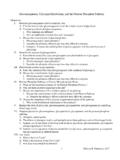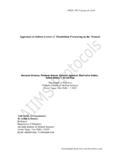Transcription of ISOAMYLASE FROM PSEUDOMONAS …
1 ISOAMYLASE from PSEUDOMONAS amyloderamosa (CTA) 2007 - Page 1(6) ISOAMYLASE FROM PSEUDOMONAS AMYLODERAMOSA Chemical and Technical Assessment Prepared by Zofia Olempska-Beer, 1. Summary This Chemical and Technical Assessment summarizes data and information on the ISOAMYLASE enzyme preparation submitted to JECFA by Bioresco on behalf of Hayashibara Co. in a dossier dated December 19, 2006 (Hayashibara, 2006). ISOAMYLASE described in the Hayashibara s dossier catalyzes the hydrolysis of 1,6- -D-glucosidic branch linkages in glycogen , amylopectin, and their -limit dextrins.
2 The enzyme is manufactured by pure culture fermentation of PSEUDOMONAS amyloderamosa strain MU 1174. This production strain is a derivative of strain MI 414, which was developed by chemical mutagenesis from the wild-type strain SB-15. The SB-15 strain is deposited in the American Type Culture Collection under the accession number ATCC 21262. P. amyloderamosa is not known to be either pathogenic or toxigenic. The P. amyloderamosa ISOAMYLASE is an extracellular enzyme that is secreted by the production strain to the fermentation broth. The fermentation broth is subsequently purified and concentrated to obtain ISOAMYLASE activity within a desired range. ISOAMYLASE is then formulated with glucose and maltose and either glycerol n-caproate and glycerol octylate or sodium benzoate.
3 Water is added to standardize ISOAMYLASE activity. The ISOAMYLASE enzyme preparation contains minor levels of cellulase, lipase, and protease activity. Hayashibara manufactures two ISOAMYLASE products, ISOAMYLASE M and ISOAMYLASE S. Both formulations contain approximately 37% of added sugars, glucose and maltose. ISOAMYLASE M contains of each, glycerol n-caproate and glycerol octylate, while ISOAMYLASE S contains sodium benzoate instead of glycerol fatty acid esters. The ISOAMYLASE enzyme preparation is intended for use in the production of food ingredients from starch, including glucose syrup, maltose, maltitol, trehalose, cyclodextrins, and resistant starch. The ISOAMYLASE enzyme preparation complies with the General Specifications and Considerations for Enzyme Preparations Used in Food Processing (JECFA, 2006).
4 2. Description The ISOAMYLASE enzyme preparation is a yellowish brown liquid. 3. Method of Manufacture PSEUDOMONAS amyloderamosa production strain P. amyloderamosa production strain MU 1174 is a derivative of strain MI 414, which was obtained from the wild-type strain SB-15 by chemical mutagenesis using N-methyl-N -nitro-N- 1 Bundesstrasse 29, 4054 Basel, Switzerland 2 2-3 Shinoishii 1-chome, Okyama 700, Japan ISOAMYLASE from PSEUDOMONAS amyloderamosa (CTA) 2007 - Page 2(6) nitrosoguanidine. The SB-15 strain is deposited in the American Type Culture Collection under the accession number ATCC 21262.
5 P. amyloderamosa SB-15 is a Gram-negative, non-sporulating, rod-shaped bacterium, which grows under aerobic conditions. The growth is optimal at 25-30oC and pH P. amyloderamosa is a naturally-occurring soil microorganism, which secrets ISOAMYLASE into its extracellular environment (Harada et al., 1968; Sugimoto et al., 1974). It is not a human pathogen and is considered nontoxigenic. An extensive literature search performed by Hayashibara did not reveal any reports on adverse reactions to P. amyloderamosa. Hayashibara has used P. amyloderamosa in the production of ISOAMYLASE since 1979 without receiving reports of allergic or other adverse reactions to both P. amyloderamosa and the ISOAMYLASE enzyme preparation.
6 To corroborate the safety of P. amyloderamosa, Hayashibara performed oral acute toxicity and pathogenicity tests in mice. The oral acute toxicity test (LD50) was performed with wet P. amyloderamosa cells and the filtrate of P. amyloderamosa culture (10 mice/sex/dose). No mortality occurred in either treatment. Hayashibara concluded that LD50 was greater than 66 g/kg for P. amyloderamosa cells and greater than 60 g/kg for the culture filtrate. In the pathogenicity test, the suspension of P. amyloderamosa cells in physiological saline was intravenously administered to mice at three dose levels (5 mice/sex/dose). The highest dose was cells per mouse. After a 15-day observation period, the mice were killed and subjected to gross necropsy.
7 Based on the results of this study, Hayashibara concluded that P. amyloderamosa does not induce acute toxic effects in mice and cannot reside and proliferate in the examined organs, , the liver, kidneys, and brain. Production Process P. amyloderamosa strain MU 1174 is cultivated at about 28oC in a standard medium containing food-grade ingredients, including dextrin, mineral salts, peptone or amino acids, and yeast extract. The fermentation conditions are monitored and the fermentation medium is periodically tested for microbial contamination. If contamination is detected, the fermentation batch is discarded. ISOAMYLASE is an extracellular enzyme, which is secreted to the fermentation medium.
8 When the desired ISOAMYLASE activity has been reached, the fermentation broth is filtered to remove the cellular debris. The enzyme solution is concentrated and purified by ultrafiltration and membrane filtration. ISOAMYLASE is then formulated with food-grade glucose and maltose and either glycerol n-caproate and glycerol octylate or sodium benzoate. Water is added to achieve the intended ISOAMYLASE activity. 4. Characterization ISOAMYLASE ISOAMYLASE described in the subject dossier catalyzes the hydrolysis of 1,6- -D-glucosidic branch linkages in glycogen , amylopectin, and their -limit dextrins. ISOAMYLASE does not catalyze the hydrolysis of pullulan, which is a linear polysaccharide consisting of maltotriose units linked by -1,6-glycosidic linkages, and has a limited activity on -limit dextrins.
9 According to the Enzyme Commission of the International Union of Biochemistry and Molecular Biology, ISOAMYLASE is classified as follows (IUBMB, 2007): ISOAMYLASE from PSEUDOMONAS amyloderamosa (CTA) 2007 - Page 3(6) Accepted name: ISOAMYLASE Reaction: hydrolysis of (1 6)- -D-glucosidic branch linkages in glycogen , amylopectin and their -limit dextrins Systematic name: glycogen -1,6-glucanohydrolase Other name(s): debranching enzyme EC: Other synonyms for ISOAMYLASE , not listed in the IUBMB monograph, are -1,6-glucan hydrolase and glycogen -6-glucanohydrolase.
10 The Chemical Abstract Service Registry Number (CAS No.) for ISOAMYLASE is 9067-73-6. ISOAMYLASE from P. amyloderamosa was initially identified and described by Harada et al., (1968). Its physico-chemical and molecular characteristics were subsequently elucidated and described in several publications (Yokobayashi et al., 1970; Yokobayashi et al., 1973; Kitagawa et al., 1975; Kainuma, et al., 1978; Katsuya et al., 1998). ISOAMYLASE has a pH optimum at pH and a temperature optimum at 52oC. The enzyme consists of 750 amino acid residues and has a molecular mass of about 80 kDa. The three-dimensional structure of ISOAMYLASE was elucidated by the X-ray structure analysis (Katsuya et al., 1998). The P. amyloderamosa gene pmi (also referred to as ISO) encoding ISOAMYLASE was cloned and sequenced (Amemura et al.)















